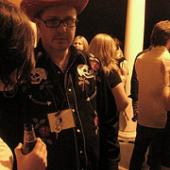We’ve just had our new year, and some amazing work has entered the public domain. The complete works of F. Scott Fitzgerald, as an example. And his contemporary, Nathaniel West, who worked with him in Hollywood and died the same year as Fitzgerald. The term of a copyright in the U.S. is the life of the creator, plus 70 years. Fitzgerald and West died in 1940. And so it is -- welcome to the public domain, dear “Gatsby.” Welcome, “Day of the Locust.” This is an especially exciting prospect for playwrights and theater companies -- it provides a multitude of works that can now be performed or adapted freely.
Or, at least, that was how it was supposed to work. In fact, these works, and millions of other lesser-known pieces, will not enter the public domain. Not until 2019. This was the result of a piece of legislation called The Sonny Bono Copyright Term Extension Act. The act, named after the singer-turned-politician who authored it, effectively froze the public domain until 2019 for any piece created after 1923. The act is sometimes pejoratively called the Mickey Mouse Protection act, because it saved Walt Disney’s mascot from becoming public property; The Disney Company, as you might imagine, was one of the companies that most aggressively lobbied for this act.
Never mind that Mickey Mouse was actually the creation of Ub Iwerks, and was based on drawings by Hugh Harman, and might have been based on a toy from the era. And never mind that Walt Disney himself borrowed extensively -- and, at times, exclusively -- from the public domain to make his films. Just to demonstrate this, here’s a partial list of Disney films whose original works would not have been in the public domain under the Bono Act: “Pinocchio,” “Song of the South,” “Treasure Island,” “Alice in Wonderland,” and “20,000 Leagues Under the Sea.” Looking at their filmography, an overwhelming majority of their feature-length works have been based on work that is in the public domain -- a trend that continues to this day, with “Treasure Planet” and “The Princess and The Frog” being two recent examples. And yet, to protect their iconic mouse, they have helped shut down the public domain from receiving new works. Never mind that an overwhelming majority of these works are orphaned creations, with nobody knowing who made them, nobody claiming ownership, and nobody profiting. For the want of a mouse, the kingdom was lost.
The importance of the public domain
I would like to make a case for the importance of a robust public domain, and why we, as artists, have a special debt to the public domain. Because things like the Sonny Bono Copyright Term Extension Act are often presented as existing for the sake of artists. They’re there, we’re told, for our good, so that we can continue to make a profit off our work throughout our life, and our children can also enjoy the benefits of our good work. And, for a very select few, this will be true. A handful among us will produce a work so popular it continues to generate money over the course of our life, and after our death.
For most of us, though, this won’t be the case. We’re not the Noel Cowards of the world. We’re lucky even to get half of our plays produced during our life, and even then, statistically, they will only be produced once. For most of us, this talk of endless rewards for our work is a bill of good, less likely than a lottery win. Who benefits most from a frozen public domain? Big corporations, who can continue reaping profits from a very small body of work long after the creators have died, and who have never shown much interest in paying out to anybody else. Does Disney still pay the family of Ub Iwerks for Mickey Mouse? Do they pay the family of Lewis Carroll? Jules Verne? No -- in fact, Disney had a protracted legal battle with the family of E.H. Shepard, the illustrator of Winnie-the-Pooh, over royalties from work made with the bear’s likeness, which they allegedly repeatedly failed to disclose. There may be examples of individual families that have benefited from the Sonny Bono act. I have scoured the Internet and failed to find mention of them, though.The act was funded by and benefits corporations, and any benefit an artist gets is incidental, and sometimes must be sued for.
But, then, what’s the harm? It’s a good question, but I think the fact that it must be asked demonstrates just how little regard there is for the public domain, and how little discussion there is of it. But we artists have a special debt to the public domain. None of us are sui generis -- we are all products of the culture that produced us. Even when creating our own work, we make anew what has been created before us, many times, by artists that preceded us. They gave us the language we use, the narrative structures we employ, and the genres we work within. To a greater or lesser extent, all writing is rewriting. And, with great frequency, it’s to a greater extent. We rewrite Greek myths. We rewrite old folk songs. We adapt older stories. We’re especially a remix culture now, but to some extent always have been. “Hamlet” was based on an older work. “Romeo and Juliet” was lifted from “The Tragical History of Romeus and Juliet” by Arthur Brooke, written in 1562, a scant 30 years before Shakespeare wrote his script -- in contemporary terms, Shakespeare was a plagiarist. And “West Side Story” rewrote Shakespeare, and so it goes.
The history of copyright
But, then, copyright laws are quite a new development. Once upon a time, the moment you created a piece of work, it entered the public domain. This is the way of things for most of the history of humanity, and the first copyright laws weren’t enacted until the 15th and 16th century. And were they created to protect the earnings of artists? No they were not. They were created to support a monopoly of printers. Even at its start, the copyright was there for corporations.
This is not to argue that extending the copyright to artists was a bad thing. But do you know what the original copyright law in the United States was for a newly created piece? Fourteen years, and it could be extended another 14 if the author was still alive. The early logic for the copyright was similar to the logic for a patent -- that an inventor was petitioning the government for a legal monopoly on something. The government was willing to provide that monopoly, but only temporarily. The repayment for this was that, eventually, the monopoly would end, and the work would be extended to the benefit of all humankind. The U.S. Constitution has consistently been interpreted as supporting a copyright only to encourage creative works for the public benefit, and the public benefit takes priority over private value.
Additionally, in the beginning, you had to register for a copyright, and had to identify the copyright on your creation, or it entered the public domain. And once it was in the public domain, it couldn’t come back out again. Not anymore. Now a work is copywritten at the moment it is created and remains so until 70 years after the creator's death. And if you don’t know who the creator was? Orphaned works are still protected by copyright. You could probably grab an illustration from an old magazine and nobody would sue you, but no publisher is willing to take that chance. And so it is that it is almost impossible to properly access most of the work of the 20th century, despite it being ownerless. Shakespeare could use a 30-year-old piece without fear of prosecution, and, up until 1970, so could anybody. Now, nothing that predates 1923 is available to us, unless it accidentally already entered the public domain.
And there are two examples of this that demonstrate how valuable the public domain is, both from the world of film. Both “It’s a Wonderful Life” and “Night of The Living Dead” accidentally went into the public domain (the former has actually achieved what is usually impossible and returned to private ownership). Without “Night of The Living Dead” being completely free to draw from, we would not have had access to one of the only new monsters of the late 20th century -- the Romero-styled zombie. This creature, which Romero could rightfully have sued to keep from appearing, in his conception of it, in later films, instead continues to generate new work, including work from Romero himself. We might not have had the recent AMC series “The Walking Dead” were it not for a goof in the copyright process that allowed “Living Dead” to slip into the public domain.
As for “It’s a Wonderful Life,” without work derived from it and from another public domain piece, “A Christmas Carol,” we wouldn’t have Christmas. Well, we might, but it wouldn’t be the same. These two pieces serve as the ur-text for 80 percent of theatrical Christmas presentations, and, as anybody who runs a theater can tell you, without those seasonal shows, most theater companies would go broke.
The future of public domain
We’re not likely to reverse the Sonny Bono act, and so be it. If we’re among the fortunate few to have work that continues to make money after our death, our children, and our children’s children, and their children’s children, will continue to profit from it. This is probably good for them, although I’ve never seen any evidence that having money that you did not personally earn has a salutary effect on one’s character. It’s probably bad for art, as children of artists have been known to destroy their parents’ art, or limit access to it -- take James Joyce’s son as an example, who has done both. But we’re stuck with it, thanks to the man who wrote “I Got You, Babe” and a company that wants to control the rights to a cartoon mouse.
But these things are worth thinking about. Because Mickey Mouse is due again to enter the public domain in 2023, and there will always be other works of art that corporations wish to keep making money from, and there will continue to be legal pushes to extend copyright indefinitely. And, as artists, we’ll be told that this is being done for our sake, to protect our interests, never mind that we’ll be long dead, and our grandchildren’s grandchildren will be long dead, by the time anybody is again able to access our work.
We’ve drawn from the public well. We make our art thanks to the people who made art before us, and whose work we can access freely, and adapt, and interpret, and revise. We owe it to future generations to pay back into that well. We are the future of the public domain, and we must be its stewards and protectors, or we are its thieves.
Max Bunny Sparber
Max "Bunny" Sparber was the guest editor of MinnesotaPlaylist from December 2010 through February 2011, as well as being a longtime arts critic and playwright. His dramatic writing can be read at
http://www.maxsparberplays.com/.




